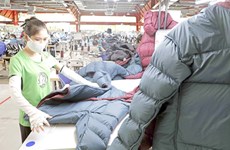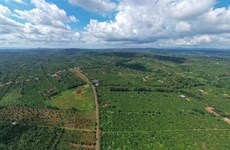WB: Vietnam navigated global financial crisis relatively well
The WB
has said, in its economic update for the East Asia and Pacific, that
Vietnam's economy navigated the global financial crisis relatively
well.
The Washington-based World Bank (WB)
has said, in its economic update for the East Asia and Pacific, that
Vietnam 's economy navigated the global financial crisis relatively
well.
The WB said the global financial crisis and economic recession slowed economic growth in Vietnam . The impact was apparent in the first quarter of 2009, when GDP increased only by 3.1 percent from a year earlier, or 4 percentage points below the average first-quarter growth for the last few years. However, positive signs of recovery have been emerging as a result of the government efforts to support economic activity.
The government announced its stimulus package which included various measures, from an interest rate subsidy, to tax breaks, and to additional capital spending.
As a result, GDP grew by 4.5 percent in the second quarter and 5.8 percent in the third, raising real GDP growth to 4.6 percent year-on-year for January-September.
According to the report, the global economic recession has had a significant impact on Vietnam’s external sector. Over the first eight months of 2009, exports declined by 14.2 percent year-on-year in dollar terms. Export turnover is down across most items and most of Vietnam ’s traditional markets. This decline is less than in other developing countries, but could make 2009 the first year with declining exports since the beginning of Vietnam ’s economic reforms.
It said that the fiscal deficit is expected to widen to 9.4 percent of GDP in 2009, reflecting a decline in revenues and a significant increase in expenditures. Revenues are projected to fall in line with the slowdown in economic activity, lower oil prices and various tax breaks included in the stimulus packages.
Monetary policy has been loosened substantially to support domestic demand after a period of tightening in 2008 to tackle overheating. The central bank cut its policy rate by half to 7 percent from mid-2008 to February 2009, the report said.
The report added that poverty levels continued to fall in Vietnam, despite the sharp increase in food and fuel prices through the first half of 2008, followed by a period of sluggish growth in late 2008 and into 2009./.
The WB said the global financial crisis and economic recession slowed economic growth in Vietnam . The impact was apparent in the first quarter of 2009, when GDP increased only by 3.1 percent from a year earlier, or 4 percentage points below the average first-quarter growth for the last few years. However, positive signs of recovery have been emerging as a result of the government efforts to support economic activity.
The government announced its stimulus package which included various measures, from an interest rate subsidy, to tax breaks, and to additional capital spending.
As a result, GDP grew by 4.5 percent in the second quarter and 5.8 percent in the third, raising real GDP growth to 4.6 percent year-on-year for January-September.
According to the report, the global economic recession has had a significant impact on Vietnam’s external sector. Over the first eight months of 2009, exports declined by 14.2 percent year-on-year in dollar terms. Export turnover is down across most items and most of Vietnam ’s traditional markets. This decline is less than in other developing countries, but could make 2009 the first year with declining exports since the beginning of Vietnam ’s economic reforms.
It said that the fiscal deficit is expected to widen to 9.4 percent of GDP in 2009, reflecting a decline in revenues and a significant increase in expenditures. Revenues are projected to fall in line with the slowdown in economic activity, lower oil prices and various tax breaks included in the stimulus packages.
Monetary policy has been loosened substantially to support domestic demand after a period of tightening in 2008 to tackle overheating. The central bank cut its policy rate by half to 7 percent from mid-2008 to February 2009, the report said.
The report added that poverty levels continued to fall in Vietnam, despite the sharp increase in food and fuel prices through the first half of 2008, followed by a period of sluggish growth in late 2008 and into 2009./.













